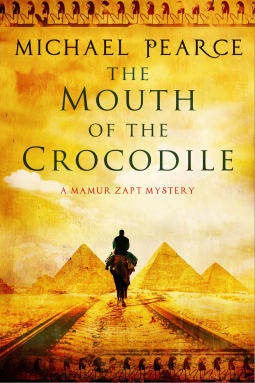
Mouth of the Crocodile, The
A Mamur Zapt mystery set in pre-World War I Egypt
by Michael Pearce
This title was previously available on NetGalley and is now archived.
Send NetGalley books directly to your Kindle or Kindle app
1
To read on a Kindle or Kindle app, please add kindle@netgalley.com as an approved email address to receive files in your Amazon account. Click here for step-by-step instructions.
2
Also find your Kindle email address within your Amazon account, and enter it here.
Pub Date 1 Mar 2015 | Archive Date 10 Feb 2015
Description
Atbara, Sudan, 1913. A dead man is fished out of the River Nile. An accident – or something more sinister? A visiting Pasha from the Royal Household believes it was murder – and that he himself was the intended target. He insists that the Mamur Zapt, Head of the Khedive’s Secret Police, escorts him on his return train journey to Cairo, for protection. It’s to be an eventful voyage. Matters take an unexpected turn when the train is stranded in the desert following a sandstorm. With the help of English schoolboy Jamie Nicholson, the Mamur Zapt pursues his investigations, convinced that at least one of his fellow passengers has a secret to hide. And what was the Pasha really doing in that remote corner of the Sudan? Could the Mamur Zapt’s deepest fears be true? Could he really be about to uncover a conspiracy against the British?
A Note From the Publisher
We will consider requests from established bloggers, Acquisition and Collection Development Public Librarians and booksellers in the UK and USA.
Available Editions
| EDITION | Other Format |
| ISBN | 9780727884633 |
| PRICE | US$28.95 (USD) |
Featured Reviews
 Nancy C, Reviewer
Nancy C, Reviewer
Although conceived as a mystery, Michael Pearce's novel is more than that: it is an atmospheric social history of Egypt and the Sudan , showcasing their sentiments toward British control.
I've read other books in the series featuring the "Mamur Zapt," but none I enjoyed as much as this one. Two precocious youngsters---one an Egyptian girl and the other a British boy--- place themselves at the center of this politically charged story. They add the life and sparkle to the novel, while subtly introducing the reader to the social plight of women in the Arab culture of the period. The energetic, ambitious, and well-connected teenagers added spice and heart to the story.
The Mamur Zapt is a protagonist that grows on you with each exposure. He is a subtle man, with quiet methodology and he is never in a hurry. Nor is this book. The reader needs to relax and accept the nature of the man and the pace of the culture. As we do that, we feel the heat of the desert, the temper of the times, and the challenges of the people who are trying to adapt to them. It was an interesting journey.
 Waheed R, Reviewer
Waheed R, Reviewer
In 1913 in Atbara, Sudan, a railway worker drowns in the Nile. An English lad, Jamie, cries murder but is ignored. The plot thickens when Owen, the Mamur Zapt (Secret Police Chief), arrives to escort a Pasha to Cairo. The Pasha, returning from a conference in Khartoum, is fearful for his life. He hides, even from Owen, some secret documents in his briefcase. Jamie also joins Owen and the Pasha, as well as his entourage, on the train to Cairo, but it gets bogged down following a fierce sandstorm. While the passengers swelter in the intense heat and endure dwindling supplies, awaiting the relief engine, Jamie befriends two teenage Arab girls. Owen fears an attack by the natives, one possibly motivated by an anti-British conspiracy.
This, Michael Pearce’s latest series novel, follows his usual formula: portraying everyday life vividly in 1900s colonial Egypt and Sudan; introducing a murder mystery that is resolved by the Mamur Zapt; and adding perceptive sociopolitical conflicts and the locals’ attitudes towards the British into the narrative. What makes this one somewhat different and adds another dimension is the inclusion of the storyline featuring the three teens, which exposes the struggles of local women. These aspects will keep the readers entertained and engaged.
This review first appeared in the HNR Issue 71 (February 2015)



